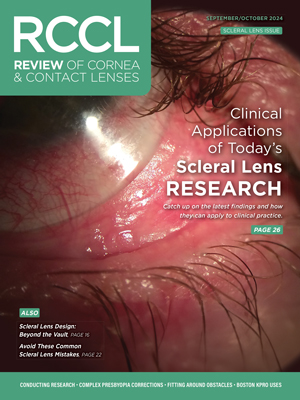Short-term scleral contact lens wear may be beneficial for patients with keratoconus who also suffer from dry eye, reports a study in the February 2016 Optometry & Vision Science.1 The rigid lenses are currently indicated for use in patients with severe corneal irregularities, including keratoconus, and have also been slated as a means to manage dry eye due to their ability to improve ocular surface integrity. To date, however, no study has investigated the effects of scleral lens wear on the ocular surface physiology of patients with keratoconus.
In an effort to remedy this discrepancy, researchers at the Complutense University of Madrid in Spain conducted an experimental pilot study involving 26 patients with keratoconus ranging from age 25 to 51. Patients were separated into those with an intrastromal corneal ring, and those without; each was fit with a 16.5mm scleral lens design that provided clearance thickness between 300μm and 400μm.
The research team administered the Ocular Surface Disease Index (OSDI) questionnaire and measured tear osmolarity, Schirmer score, tear break-up time, matrix metalloproteinase-9 (MMP-9) concentration and Ap4A concentration before and after eight hours of lens wear. No significant changes were identified during the Schirmer test and tear break-up time following lens wear. OSDI scores and osmolarity were lower and MMP-9 concentration was higher, however, in both groups following lens wear. Lastly, Ap4A concentration was lower following lens wear in the keratoconus group, but not the corneal ring group. These results, the researchers say, demonstrate that “symptomatology, osmolarity and Ap4A concentration decrease after short-term scleral lens wear in KC patients, but MMP-9 concentration rises significantly.”
The researchers note that the lenses used in the study were manufactured using a high Dk material and 0.3mm of central thickness. “There is no evidence of the influence of the physical properties and scleral lens design over the ocular surface physiology,” they say. “In the future, however, it might be interesting to evaluate the differences between different scleral lens designs, taking into account the central thickness, overall diameter and adaption period.
“In conclusion, short-term scleral lens wear improves the symptomatology and some signs of dry eye, such as osmolarity and Ap4A concentration, in keratoconus patients. However, there is an increase of MMP-9 concentration, probably because of tear film stagnation and the use of preserved saline for filling the lenses.”
1. Carracedo G, Blanco MS, Martin-Gil A, et al. Short-term effect of scleral lens on the dry eye biomarkers in keratoconus. 2016 Feb;93(2):150-7.


